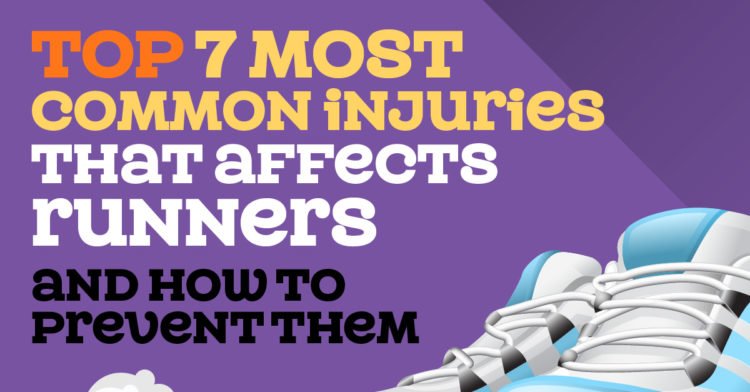A staggering statistic shows that 65% of all runners are injured within a given year. A statistic that reveals runners are suffering from common injuries that are avoidable. 50% of injuries are recurring injuries.
By equipping yourself with the right knowledge, you can avoid injuries.
On average, an injury occurs every 100 hours of running. Runner's lose 10% of what they could have gained due to recovering from injury.
So how do you avoid getting injured? Here are the seven most common running injuries, and how to prevent them.

Share this Image On Your Site With The Code Below
Summary of Top 7 Most Common Running Injuries that Affects Runners
1. Runner's Knee
Runner's knee is the top common injury for runners at a prevalence of 40%. It prevails over other injuries and has an underlying cause. The underlying reason for runner's knee is cartilage breaking down behind your knee cap. As it creates irritation and pain, it is tearing down the needed cartilage to keep your body healthy for running.
The causes of runner's knee involve extra pressure on the knee (takes up 30% pressure of joint), long runs, extensive sitting, and descending hills or stairs.
Recovery tips include reducing your mileage, avoiding downhill running, and cross train by using an elliptical, bike, or pool. To prevent runner's knee more long term, consider shortening your stride, landing with your knee slightly bent, stretching your hip flexors, and strengthening your glutes. Take note of any knee pain, especially if it does not decrease as the day goes on.
2. Achilles Tendonitis
Achilles tendonitis has a prevalence of 11%. Signs and symptoms include the tendon that connects your calf and heel becoming tight and irritated.
Dramatically increasing training, as well as weak calves can cause achilles tendonitis. By stopping all running, avoiding cycling, applying ice, and training using an elliptical or pool, you can recover faster.
To prevent the second top injury, do calf raises, avoid excessive calf stretching, and avoid wearing high heels or flip-flops for long periods of time.
If you experience severe pain or swelling, consider seeking professional treatment.
3. Hamstring Issues
Hamstring issues have a 7% prevalence. Signs and symptoms will reveal that hamstring issues include the muscle that runs down the back of your thighs and knees becomes tight or feels weak.
Causes and susceptibility include weak hamstring muscles, extreme flexibility or inflexibility of overstretched or too tight of muscles, and quad muscles that are disproportional to hamstring size.
Recovery tips involve slowing your pace, avoiding hills, using a foam roller before and after runs, getting a deep-tissue massage, and training using a bike or pool.
To avoid having hamstring issues long term, try strengthening techniques of one-legged deadlifts or bridges and wear compression tights when running to increase blood flow. If strong pain persists, or you see bruising, seek medical attention as it can cause severe injury.
4. Plantar Fasciitis
Plantar fasciitis has a prevalence of 15%. It can feel like an aching on the top of your foot or the bottom of your heel. Signs and symptoms will reveal that the tendons and ligaments running from your heels to your toes receive small tears or inflammation.
Causes and susceptibility include very high or very low arches, pronation, supination, long periods of standing, and weak core strength. Recover by choosing to ease up on running or take a break until fully recovered. Ice your heel, arch, or top of foot, pull back toes to stretch your arch, use a foam roller, and train using a bike or pool.
Ongoing preventative tips involve increasing your core strength with planks or back extensions, wearing proper shoes for your foot type, and stretching your arches. If pain proceeds, choose to rest and avoid running.
5. Shin Splints
Shin splints has a prevalence of 15%. Signs and symptoms will show an achy feeling in your shins as a result of small tears in the surrounding muscles.
Causes and susceptibility reveal that shin splints occurs in new runners or runners coming back from a long break, running in a shoe that is too worn or inappropriate for your foot type, and in people with extremely high arches or flat feet.
Recovery tips are to reduce mileage, rest, apply ice, tape your shin, and train using a bike or pool.
To prevent shin splints long term, increase mileage gradually if you are a new runner or are coming back from a long break and wear proper shoes for your foot type. If it hurts to walk, then seek treatment as it can be a serious injury.
6. Iliotibial Band Syndrome
Iliotibial Band Syndrome prevails at 12%. Signs and symptoms reveal the band that runs along the outside of your leg from the hip to the knee becomes irritated and achy.
Causes and susceptibility include increased mileage too quickly, and lots of downhill running. Recover by choosing to reduce mileage, avoid hiking and cycling, use a foam roller, and train using a pool or elliptical.
Prevent shin splints from happening by strengthening your abductors (lateral side steps, side leg lifts, on legged squats). If running on a track, change directions every few laps and limit hilly runs while also shortening your stride. If you experience pain by walking or going downhill, then refrain from running.
7. Stress Fracture
Stress fracture has a prevalence of 6%. Signs and symptoms will show a strain on your bone that results in an achy feeling in your shins, feet or heels.
Causes and susceptibility involve a drastic increase in mileage or speed as well nutritional deficits and inadequate calorie intake. Recover by allowing yourself to take a significant break from impact exercises, pace yourself (even when walking) and train using a pool.
Prevent a stress fracture long term by consuming enough calories and nutrients, and weight train to improve bone density. If it is uncomfortable to simply be on your feet, then you should not be running. Your body needs to rest.

